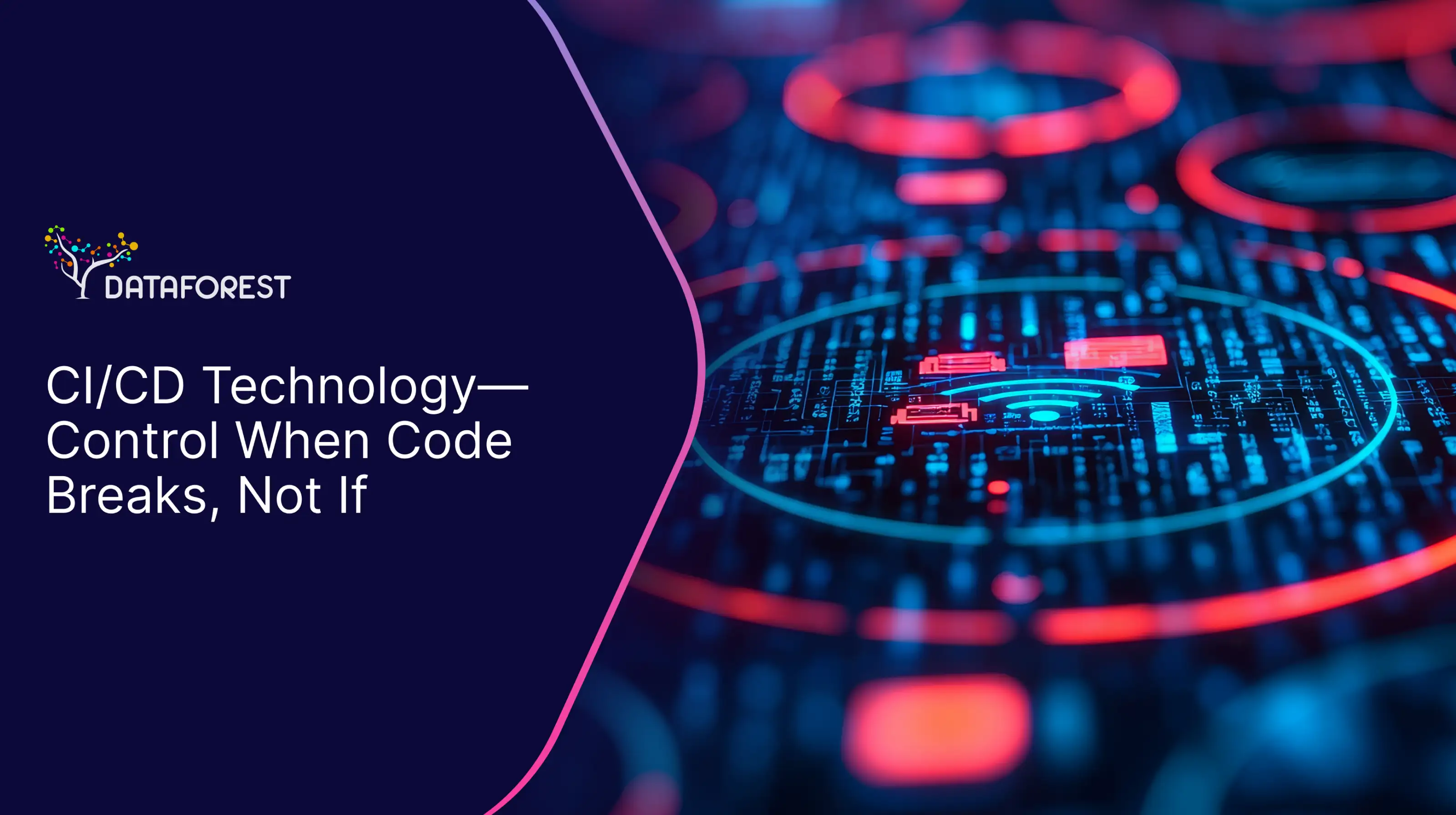
Incident Management and Monitoring: Digital Pulse Service
Using all our knowledge and experience, DATAFOREST provides real-time system observability and resilient response through telemetry collection, intelligent alerting mechanisms, automated alert correlation, and cross-platform integration of monitoring tools. As a result, we have end-to-end visibility into infrastructure, application performance, and user experiences.




PARTNER

PARTNER
FEATURED IN

01
Monitor Infrastructure
IT infrastructure monitoring is achieved by deploying multi-layered sensor agents across physical, virtual, and cloud environments that collect real-time granular performance metrics, resource utilization, and system state data, ensuring infrastructure reliability.
02
Detect Incidents
A real-time incident management monitoring service utilizes advanced event correlation engines and streaming analytics to identify anomalies, performance degradations, and potential system failures by comparing operational data against machine learning-based incident management behaviors. This forms the backbone of real-time anomaly detection.
03
Predict Anomalies
Predictive incident management solutions employ machine learning algorithms and statistical models to analyze historical system performance data, identifying subtle patterns and potential future disruptions before they manifest as critical incidents.
04
Manage Alerts
Intelligent incident management platforms utilize intelligent filtering, prioritization algorithms, and context-aware routing to minimize noise, escalate critical issues to the appropriate teams, and prevent alert fatigue through effective notification mechanisms.
05
Observe Systems
Cross-system observability frameworks create unified monitoring dashboards that integrate metrics, logs, and traces from diverse technological stacks, providing comprehensive IT visibility into system interactions and dependencies for DevOps incident management.
06
Analyze Root Causes
Advanced root cause analysis tools use diagnostic algorithms and dependency mapping to trace complex incident origins, identifying the fundamental source of system disruptions. These capabilities are essential for intelligent incident management and downtime prevention.
07
Monitor Performance
Proactive performance monitoring tracks system metrics, application response times, and resource consumption using predictive thresholds and dynamic scaling recommendations. This layer is foundational to AI/ML predictive incident management solutions.
08
Respond to Incidents
Integrated incident management system solutions provide end-to-end workflow management, from initial detection through resolution, with automated remediation scripts, collaborative communication channels, and structured escalation protocols. This level of incident response automation accelerates issue resolution.
09
Disaster Recovery and Backup Management
Ensuring reliable backups and recovery processes to minimize downtime and data loss during major incidents is a core capability of robust incident management systems.
10
Expand Monitoring
Enterprise-wide monitoring ecosystems create interconnected observation networks that standardize monitoring practices, share intelligence across different technological domains, and provide centralized governance for organizational visibility. These are enhanced through an integrated incident management database.
Incident Management Process
Our DevOps incident management paradigm shifts from passive observation to active anticipation, treating technological systems as living, interconnected organisms that require predictive incident management solutions.

System Instrumentation
Deployment of monitoring agents, sensors, and telemetry collectors across all technological ecosystems to capture granular performance and health data.
01

Baseline Establishment
Build operational norms using machine learning incident management algorithms.
02
.svg)
Data Collection
Implement real-time, multidimensional data streaming that captures metrics, logs, traces, and system events across infrastructure, applications, and user experiences.
03

Anomaly Detection
Continuous analysis with AI/ML predictive incident management solutions.
04
.svg)
Intelligent Alerting
Deploy context-aware alert management systems that prioritize, filter, and route potential incidents. Context-aware alerting is a key component of incident management automation.
05
.svg)
Diagnostic Analysis
Execute automated root cause investigation using correlation engines and dependency mapping to identify the fundamental source of detected anomalies.
06

Incident Workflow Activation
Trigger predefined, adaptable incident response protocols with automated initial diagnostics. Launch of predefined protocols in incident management systems.
07
.svg)
Remediation Execution
Implement context-specific resolution strategies, including automated self-healing mechanisms, guided manual interventions, or predefined recovery scripts.
08
.svg)
Performance Restoration
Actively monitor and validate system recovery, ensuring a complete return to optimal operational parameters and minimal service disruption.
09

Comprehensive Retrospective
Conduct thorough post-incident analysis, generating insights, updating predictive models, and making improvements driven by the incident management database.
10
Infrastructure Observability Challenges
Our integrated philosophy of technological resilience leverages artificial intelligence, machine learning, and incident management automation to anticipate, prevent, and rapidly resolve system challenges before they become critical disruptions.

Undetected system performance issues
Implement advanced AI/ML predictive incident management solutions with continuous, granular monitoring across all system layers.

Delayed incident response times
Deploy intelligent, automated alert routing and real-time correlation engines through automated incident management systems that enable instant incident detection and immediate response protocols.
.svg)
Fragmented monitoring approaches
Develop incident management monitoring services that integrate monitoring across diverse technological ecosystems and break down organizational silos.
.svg)
High operational disruption risks
Create adaptive, self-healing infrastructure with DevOps incident management tools and predictive failure prevention mechanisms.

Complex multi-system interdependencies
Use dependency mapping and context-aware monitoring within incident management systems to understand and visualize system relationships.
.svg)
Manual incident management inefficiencies
Implement AI-driven incident workflow automation with intelligent triage and contextual resolution recommendations.
.svg)
Limited predictive capabilities
Leverage machine learning incident management models trained on extensive historical performance data to anticipate potential system failures before they occur.

Lack of holistic system visibility
Design integrated monitoring dashboards that provide end-to-end, real-time insights across infrastructure, applications, and user experiences.

High mean time to resolution (MTTR)
Develop intelligent root cause analysis tools with automated diagnostic workflows that reduce MTTR with intelligent incident management.
.svg)
Inconsistent alert management
Eliminate alert fatigue with predictive incident management solutions that prioritize based on severity, impact, and relevance.

End-to-End System Visibility
A technological perspective that provides real-time insights across all interconnected system components, revealing intricate relationships and potential vulnerabilities. Delivered via unified incident management monitoring services.

Predictive Failure Prevention
Advanced machine learning and statistical modeling that anticipate potential system failures by analyzing historical data, current performance metrics, and subtle anomaly patterns through AI/ML predictive incident management solutions.
.svg)
Rapid Incident Resolution
Automated, intelligence-driven incident response mechanisms dramatically reduce mean time to resolution through intelligent routing, contextual analysis, and pre-configured remediation workflows.

Minimizing System Downtime
Proactive monitoring and instantaneous detection strategies that identify and mitigate potential disruptions with predictive detection in enterprise incident management.
.svg)
Performance Optimization
Continuous analysis of system resources, workload patterns, and performance metrics to recommend and implement efficiency improvements dynamically.
.svg)
Intelligent Alert Prioritization
Sophisticated filtering and contextualization of system alerts that eliminate noise, focus on critical issues, and prevent alert fatigue for technical teams—a core of intelligent incident management.
.svg)
Complex Infrastructure Diagnostics
Advanced root cause analysis tools within our incident management system enable navigation of technological ecosystems to precisely identify the fundamental sources of system disruptions.

Automated Incident Workflow Management
Streamlined, AI-powered incident response processes that automatically diagnose, escalate, and initiate resolution protocols provided through robust automated incident management frameworks.
.svg)
System Health Insights
Multidimensional metrics derived from incident management databases yield nuanced, actionable health scores that reflect the intricate well-being of technological infrastructures.

Strategic Operational Resilience
A holistic approach to technological governance transforms monitoring from a reactive task to a strategic business capability, ensuring continuous adaptation and reliability.
Proactive System Health Related Articles
All publicationsFAQ On Incident Management Automation
How quickly can you detect potential system failures?
Our incident management monitoring services detect potential system failures in milliseconds to seconds, leveraging real-time AI-powered anomaly detection algorithms. The ultra-fast detection is achieved through continuous data streaming, machine learning-enhanced pattern recognition, and intelligent correlation engines that instantly identify subtle performance deviations.
What's the average reduction in downtime after implementation?
Typical implementations demonstrate an average reduction of 60-80% in system downtime by implementing predictive failure prevention and automated incident management. Our approach transforms reactive troubleshooting into proactive system management, minimizing service interruptions through intelligent monitoring and rapid remediation strategies.
How do you handle monitoring across different technological ecosystems?
We utilize advanced, vendor-agnostic monitoring frameworks that seamlessly integrate across diverse technological ecosystems, including cloud, on-premise, hybrid, and multi-cloud infrastructures. Our incident management systems use vendor-neutral tools, enabling seamless integration across cloud, hybrid, and on-prem environments with consistent data flow into a centralized incident management database.
Can your solution integrate with our existing infrastructure?
Our enterprise incident management platform integrates via APIs, agents, and standard protocols with minimal disruption and complete compatibility. The integration process is minimally invasive, ensuring rapid deployment with near-zero disruption to current operational workflows.
What level of customization is possible?
We offer extensively customizable monitoring solutions that can be tailored to specific organizational needs, from granular metric tracking to industry-specific performance indicators. Customization spans alert configurations, dashboard designs, reporting mechanisms, and adaptive machine-learning models that can be fine-tuned to unique technological environments.
How do you prioritize and escalate incidents?
Using intelligent incident management algorithms, we rank issues by severity and business impact, automating routing and escalation to reduce delays and improve resolution workflows. The escalation process involves dynamic routing to appropriate technical teams, with automated severity classification and predefined response workflows.
What metrics do you use to measure system health?
We use a multi-metric approach—including latency, CPU/memory utilization, error rates, user behavior, and predictive incident management solution indicators—to generate actionable health scores across the tech stack. These metrics are synthesized into holistic health scores that provide nuanced and actionable insights into the well-being of the technological ecosystem.
How does your approach differ from traditional monitoring?
Our incident management system is proactive and powered by AI. We move beyond threshold-based alerts and deliver a DevOps incident management framework that evolves and learns, offering real-time diagnostics, prediction, and autonomous response.
Let’s discuss your project
Share project details, like scope or challenges. We'll review and follow up with next steps.







.svg)




.webp)
























.svg)













